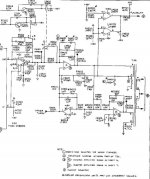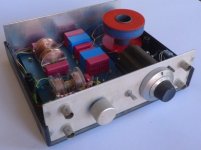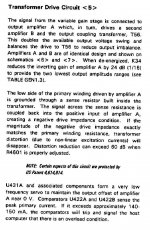That AP output stage with the transformer is a beauty. The transformer non-linearity is cancelled, sort of, with pos feedback in the driver stage. A source with <-120dB harmonics, with transformers and relays. Eat your heart out, transformer-and-relay-haters! (I could post the circuit if anyone is interested?).
This is one of several patents in that instrument. After 25 years (and AP just announced end-of-service for the S1) this still remains one of the best instruments if not THE best in it's area. When you think hard and long about a distortion analyzer, chances are you come up with a used S1 for the money.
Sorry for the off-topic rant; I LOVE these things for flawless design and execution.
Jan Didden
This is one of several patents in that instrument. After 25 years (and AP just announced end-of-service for the S1) this still remains one of the best instruments if not THE best in it's area. When you think hard and long about a distortion analyzer, chances are you come up with a used S1 for the money.
Sorry for the off-topic rant; I LOVE these things for flawless design and execution.
Jan Didden
john curl said:I feel your pain. Ask PMA what we gave him for helping us.
There might be a small misunderstanding. It was a colleague of mine who bought Parasound Halo JC-2 and was in contact with Parasound technicians. The colleague found that problem with input impedance, but was unable to explain this to Parasound (they did not understand what he was writing). So he asked me to review and help. Then I made a drawing and sent directly to John Curl, and things started to move. It was that colleague who initiated everything, and him who was awarded. I do not know what you gave him for helping you.
janneman said:(I could post the circuit if anyone is interested?).
Yes please
http://www.diyaudio.com/forums/showthread.php?s=&threadid=133834&highlight=
SY said:Andy, Scott, you guys remember the Rapapport?
Yes, he was a good customer circa 1972 when we made dual matched NPN's and PNP's.
1audio said:............
I would also use something like AP's transformer isolation on the output to remove ground loops.
...........
I did just that, that is, by means of critical coupled band filters at 1, 5 and 20kHz. See pic.
Attachments
Edmond Stuart said:
I did just that, that is, by means of critical coupled band filters at 1, 5 and 20kHz. See pic.
Looks familiar. I did this sort of thing to enhance my Sound Technology 1700.
Rappaport
As you might gather from Jacco and Scott, it was a cult solid state class A amp from the '70s. A particular favorite of Peter Aczel and Audio Critic. Half-life measured in days. And really class A- you could cook breakfast on it.
I think Andy Rappaport was a distant cousin of mine.
http://en.wikipedia.org/wiki/Andrew_S._Rappaport
As you can see, he's moved on to more useful and remunerative areas than high end audio.
SY, I don't remember that one. What was the story with it?
As you might gather from Jacco and Scott, it was a cult solid state class A amp from the '70s. A particular favorite of Peter Aczel and Audio Critic. Half-life measured in days. And really class A- you could cook breakfast on it.
I think Andy Rappaport was a distant cousin of mine.
http://en.wikipedia.org/wiki/Andrew_S._Rappaport
As you can see, he's moved on to more useful and remunerative areas than high end audio.
G.Kleinschmidt said:
From the service manual
Attachments
SY said:distant
Stuart,
considering that Mr Rappaport gave away a total of well over $10M in various contributions and that his 1/6th share investment vehicle just reached the $2B mark earlier this week, you'd wish he were a very close cousin.
The three audio products from his youth days could well be nominated for the most shabby and unreliable looking US manufacture (export) gear ever.
Ironic, no ?
Re: Rappaport
Wow. Blast from the past. I still have those issues. And Aczel is still putting out a review once a year.
SY said:
As you might gather from Jacco and Scott, it was a cult solid state class A amp from the '70s. A particular favorite of Peter Aczel and Audio Critic. Half-life measured in days. And really class A- you could cook breakfast on it.
I think Andy Rappaport was a distant cousin of mine.
http://en.wikipedia.org/wiki/Andrew_S._Rappaport
As you can see, he's moved on to more useful and remunerative areas than high end audio.
Wow. Blast from the past. I still have those issues. And Aczel is still putting out a review once a year.
I first met Andy Rappaport at a CES in the 1970's to welcome him into the club of designers. He was just a kid to me then, being 15 years younger. He was over his head, but he didn't know it then. I knew that he went to EDN, but he has been successful where others have not.
Scott, do you know the 'peak beta' current of the Analog Device dual transistors, the AD810, AD820?
john curl said:Scott, do you know the 'peak beta' of the Analog Device dual transistors, the AD810, AD820?
Is that a trick question? Even I don't have any of those and the numbers have been recycled so there is no way to find an old datasheet. Things have moved on in 30yrs.
BTW I'm surprised that you, Nelson, and PMA have not participated more in the Krill thread. First Watt performance is there in black and white, THD in the numerical noise at only 25mA of output bias and no feedback.
For the record, the peak beta is between .5ma and 1ma. These devices are still made by Linear Systems, the folks who are also making Toshiba replacements.
I have not responded on the Krill thread, because I would first like to see practical measurements, before I said anything significant.
jacco vermeulen said:[snip]The three audio products from his youth days could well be nominated for the most shabby and unreliable looking US manufacture (export) gear ever.
Ironic, no ?
Ironic? No, very smart. Better to change horses in midstream then to continue to make shabby stuff till your last breath, no?
This guy apparently was smart enough to see what he was good at and what not and acted accordingly.
Ony a fraction of humanity can do that.
Jan Didden
- Status
- Not open for further replies.
- Home
- Amplifiers
- Solid State
- John Curl's Blowtorch preamplifier

 )
)
